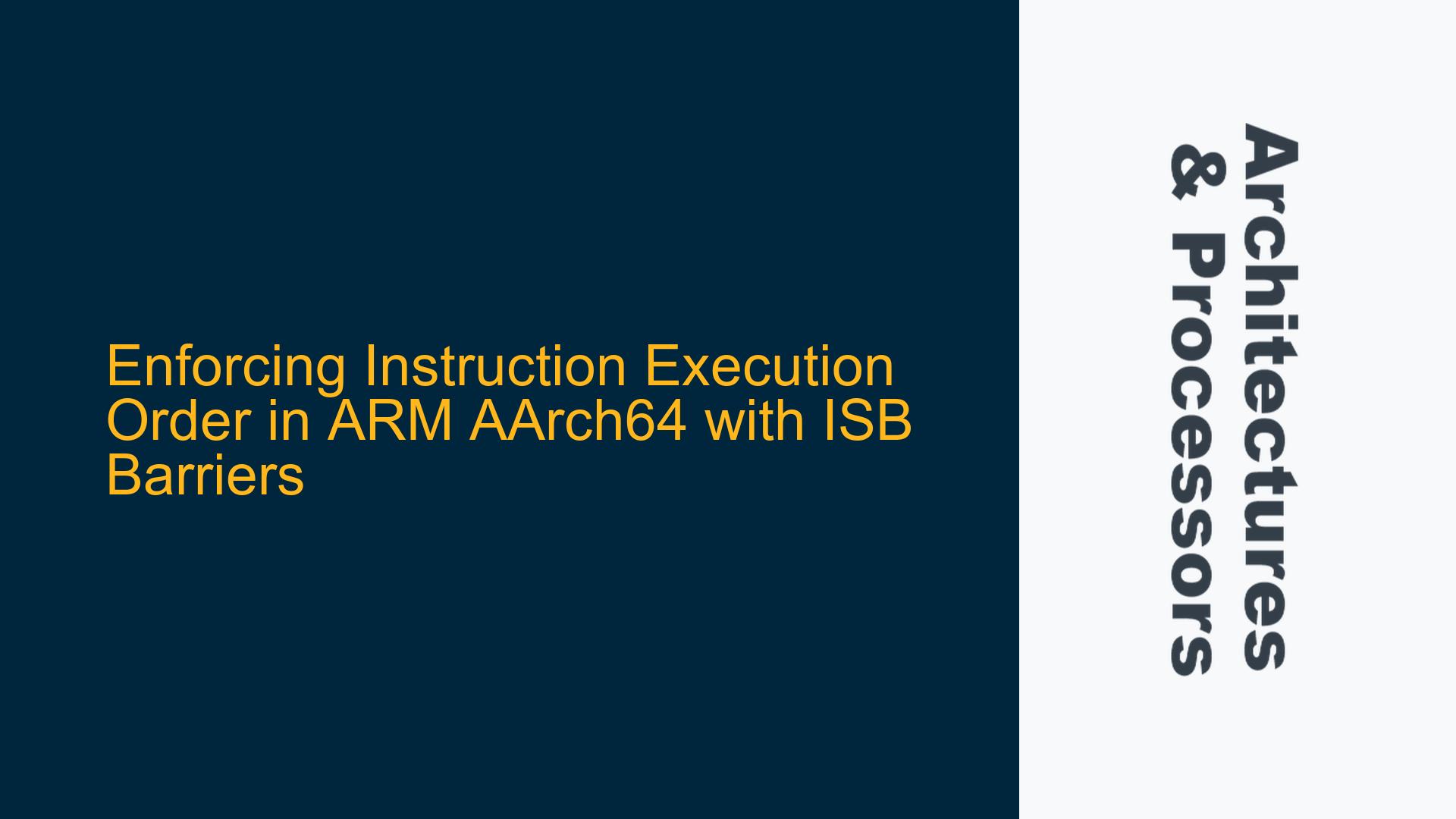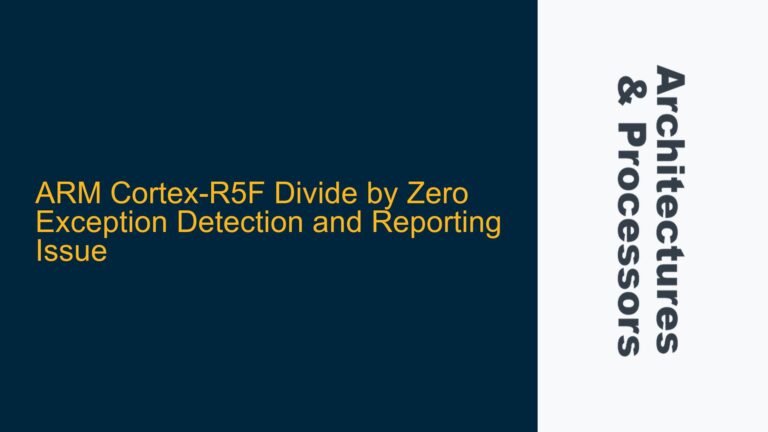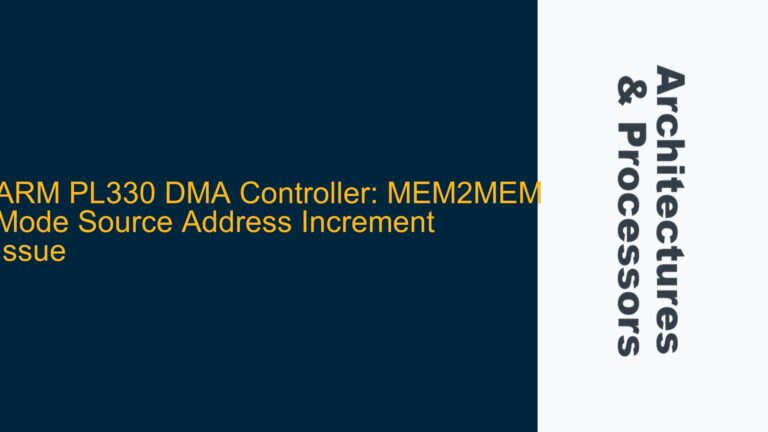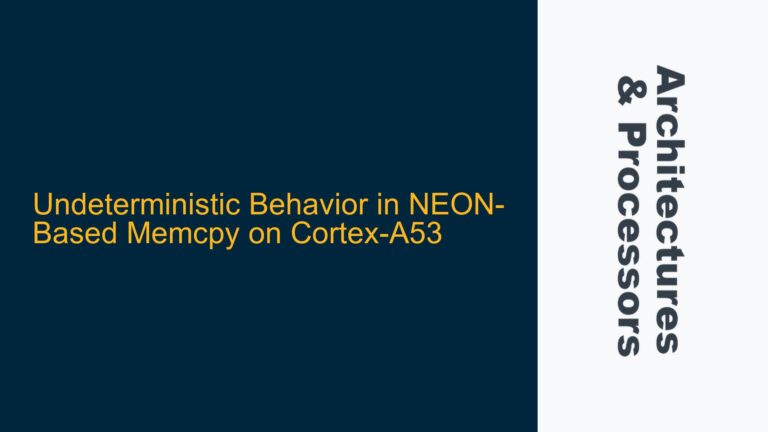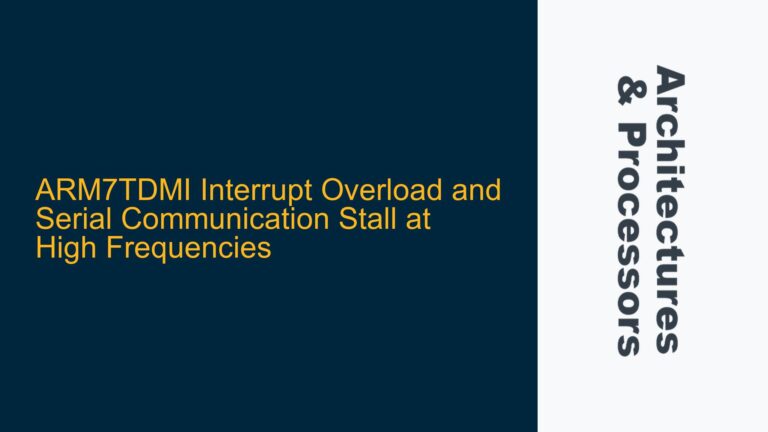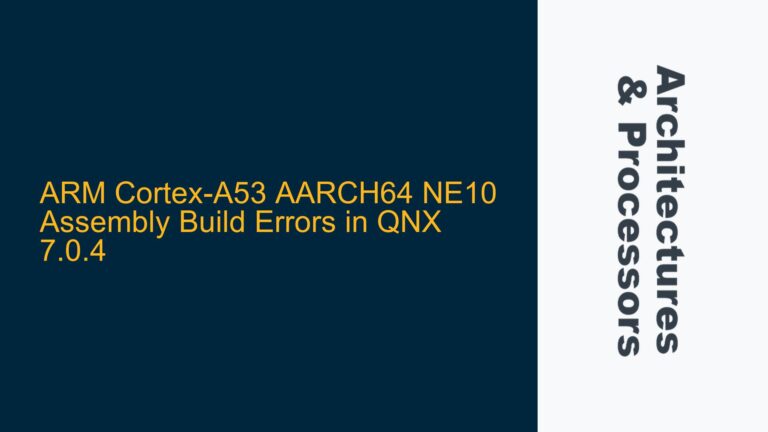ARM Cortex-A Series Instruction Reordering and System Register Synchronization
In ARM AArch64 architectures, particularly in the Cortex-A series, the processor’s out-of-order execution capabilities can lead to subtle issues when dealing with system registers and memory operations. The specific scenario involves ensuring that a write to the Performance Monitors Control Register (PMCR_EL0) is completed before a subsequent store operation to memory. This requirement arises because system register updates, such as those to PMCR_EL0, may not be immediately visible to subsequent instructions due to the processor’s pipeline and speculative execution mechanisms.
The ARM architecture provides several synchronization primitives to enforce ordering constraints between instructions. These include Data Memory Barrier (DMB), Data Synchronization Barrier (DSB), and Instruction Synchronization Barrier (ISB). Each of these barriers serves a distinct purpose in managing memory and instruction ordering. In this context, the focus is on the ISB instruction, which ensures that all preceding instructions are completed before any subsequent instructions are executed. This is particularly critical when modifying system registers, as the effects of such modifications must be globally visible before proceeding with further operations.
The PMCR_EL0 register is part of ARM’s performance monitoring infrastructure, and its configuration can influence the behavior of performance counters and other monitoring features. When a program writes to PMCR_EL0 and immediately performs a memory store operation, there is a risk that the store operation could be executed before the PMCR_EL0 update is fully effective. This can lead to inconsistent or incorrect behavior, especially in performance-critical or real-time systems where precise timing and ordering are essential.
Instruction Synchronization Barrier (ISB) as a Solution for System Register Updates
The primary cause of the issue lies in the ARM architecture’s ability to reorder instructions for performance optimization. While this reordering is generally beneficial, it can cause problems when dealing with system registers that have global effects. In the case of PMCR_EL0, the processor may not immediately apply the new configuration, leading to a situation where the subsequent store operation is executed with outdated or incorrect settings.
The ISB instruction is specifically designed to address this issue. When an ISB is executed, it flushes the processor’s pipeline, ensuring that all previous instructions, including system register updates, are completed before any further instructions are executed. This makes the ISB an essential tool for enforcing strict ordering constraints in scenarios where system register modifications must be globally visible before proceeding.
In contrast, DMB and DSB instructions are primarily concerned with memory access ordering. DMB ensures that memory accesses before the barrier are completed before any memory accesses after the barrier, while DSB extends this guarantee to include all explicit memory accesses and cache maintenance operations. However, neither DMB nor DSB affects the visibility of system register updates, which is why they are not suitable for this specific use case.
The ARM Architecture Reference Manual for A-profile architecture provides detailed documentation on the synchronization requirements for AArch64 system registers. According to the manual, an ISB is required after writing to a system register if the subsequent instructions depend on the new configuration. This ensures that the processor’s pipeline is flushed and the new register settings are fully effective before any dependent operations are performed.
Implementing ISB for Correct System Register and Memory Operation Ordering
To enforce the correct execution order between the write to PMCR_EL0 and the subsequent store operation, an ISB instruction must be inserted between the two instructions. The sequence would look like this:
MSR PMCR_EL0, X1 // Write to PMCR_EL0
ISB // Instruction Synchronization Barrier
STR X0, [X2] // Store operation
The MSR instruction updates the PMCR_EL0 register with the value in register X1. The ISB ensures that this update is fully effective before the STR instruction stores the value in register X0 to the memory location pointed to by register X2. This guarantees that the store operation is performed with the correct PMCR_EL0 configuration.
It is important to note that the ISB instruction has a performance cost, as it forces the processor to flush its pipeline and wait for all previous instructions to complete. Therefore, it should be used judiciously and only when necessary to enforce strict ordering constraints. Overuse of ISB can lead to unnecessary performance degradation, particularly in performance-critical code paths.
In addition to the ISB, developers should also be aware of other synchronization mechanisms provided by the ARM architecture, such as DMB and DSB, and understand their appropriate use cases. While these instructions are not suitable for enforcing system register visibility, they are essential for managing memory access ordering in multi-core and multi-threaded environments.
To summarize, the correct approach to enforcing the execution order of the MSR and STR instructions in this scenario is to insert an ISB between them. This ensures that the update to PMCR_EL0 is fully effective before the store operation is performed, preventing any potential issues caused by instruction reordering. Developers working with ARM AArch64 architectures should familiarize themselves with the various synchronization primitives and their appropriate use cases to ensure correct and efficient system behavior.
Detailed Analysis of ARM Synchronization Primitives and Their Use Cases
The ARM architecture provides a comprehensive set of synchronization primitives to manage instruction and memory ordering. These primitives are essential for ensuring correct behavior in multi-core, multi-threaded, and real-time systems. Below is a detailed analysis of the key synchronization instructions and their use cases:
Instruction Synchronization Barrier (ISB)
The ISB instruction is used to ensure that all previous instructions are completed before any subsequent instructions are executed. This is particularly important when modifying system registers, as the effects of such modifications must be globally visible before proceeding with further operations. The ISB flushes the processor’s pipeline, ensuring that all previous instructions, including system register updates, are completed before any further instructions are executed.
Data Memory Barrier (DMB)
The DMB instruction ensures that memory accesses before the barrier are completed before any memory accesses after the barrier. This is useful for managing memory access ordering in multi-core and multi-threaded environments, where different threads or cores may be accessing shared memory locations. The DMB does not affect the visibility of system register updates, so it is not suitable for enforcing system register synchronization.
Data Synchronization Barrier (DSB)
The DSB instruction extends the guarantees provided by the DMB to include all explicit memory accesses and cache maintenance operations. Like the DMB, the DSB is primarily concerned with memory access ordering and does not affect the visibility of system register updates. The DSB is useful for ensuring that all memory operations, including cache maintenance, are completed before proceeding with further instructions.
Use Case Comparison
| Synchronization Primitive | Purpose | Use Case |
|---|---|---|
| ISB | Ensures all previous instructions are completed before any subsequent instructions are executed | Enforcing system register visibility |
| DMB | Ensures memory accesses before the barrier are completed before any memory accesses after the barrier | Managing memory access ordering in multi-core and multi-threaded environments |
| DSB | Ensures all explicit memory accesses and cache maintenance operations are completed before proceeding | Ensuring all memory operations, including cache maintenance, are completed |
Practical Considerations
When working with ARM architectures, it is crucial to understand the specific requirements of your application and choose the appropriate synchronization primitives accordingly. Overuse of synchronization instructions, particularly ISB, can lead to unnecessary performance degradation. Therefore, it is important to use these instructions judiciously and only when necessary to enforce strict ordering constraints.
In summary, the ARM architecture provides a robust set of synchronization primitives to manage instruction and memory ordering. Understanding the specific use cases and appropriate application of these primitives is essential for ensuring correct and efficient system behavior. By carefully analyzing the requirements of your application and selecting the appropriate synchronization mechanisms, you can avoid subtle issues and achieve optimal performance in your ARM-based systems.
